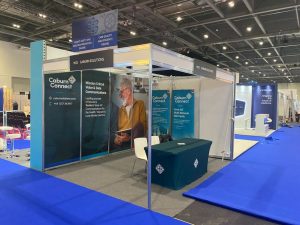Caburn Solutions are an innovative, and specialised Internet-of-Things (IoT) company with a background in health, environmental and social-care monitoring. Our focus being the development of ground-breaking managed home gateways and sensors which place occupant privacy, wellbeing, and security to the fore. Our innovative approach to home monitoring removes barriers between smart-home technologies, telehealth and indoor environmental-monitoring. Where a range of different commercially available and highly specialised sensors are connected to a single gateway. Our secure cloud-based systems ingest data for visual presentation and analysis while notifying stakeholders to act via simple messaging or instructions.
We are now applying these technologies to advancing the understanding of indoor-air-pollutants. Important, as they have been linked to poor-health, reduced sense of well-being and as sources of discomfort; while triggering or exacerbating health problems for those at higher-risk (Northcross, et al., 2015). Such monitoring systems are conventionally absent, or at best snapshot interventions via manual, on-site sample collection. Given the likely implications on health, comfort and productivity, there are calls for new studies employing in-depth real-time monitoring and measurement via remote live-sensors (Kelly & Fussell, 2019).
To meet this need, Caburn Solutions have developed and integrated the ability to remotely monitor/measure levels of three important, measurable pollutants: Volatile Organic Compounds (VOC’s), Carbon Dioxide (CO2) and Carbon Monoxide (CO).
These three important primary indoor pollutants are described in more detail below:
Volatile-Organic-Compounds
Numerous chemicals which fall into the area of VOC’s have been evidenced to “three mechanisms: sensory perception of the environment, weak inflammatory reactions, and environmental stress reactions” (Mølhave, 1991, p. 357). Epidemiological studies have shown even low-levels of exposure to VOC’s may result in a spectrum of mild to severe illnesses ranging from sensory or respiratory irritation, cough, allergies, asthma (Rumchev, et al., 2007; EPA, 2020) to “very severe effects, including cancer” (Rumchev, et al., 2007, p. 67). Occurring VOCs1 have therefore been classified by the EU as priority pollutants due to their carcinogenic effects (Sarigiannis, et al., 2011). Sources of VOCs can include; building-materials, paints, heating, ventilation/air conditioning systems, furnishings, clothing, cosmetic-care products or personal behaviours (i.e. tobacco) and are exacerbated by temperature and humidity (EPA, 2020; Rumchev, et al., 2007). VOC’s occurrence can vary greatly between individual settings (Sarigiannis, et al., 2011). VOC’s expelled by occupants may even indicate their health or wellbeing; their respiratory-excretion potentially indicating the prevalence of chronic-inflammation and/or oxidative stress (Boots, et al., 2012). In totality, measuring amounts of VOCs in a room may therefore be applied as a general safeguarding, monitoring or analytical tool (ibid).
Carbon-Dioxide
The presence of raised levels of CO2 raises toxicity-levels by displacing Oxygen (O2) (Rice, 2014). Many-days of low-exposure may increase lung-dead-space-volume, reduce cerebral-blood-flow, or increase blood-pressure (ibid). CO2 can fluctuate through time, day or room-occupancy and is linked to significant effects on personal/childhood educational performance, erratic or abnormal behavior (Myhrvold, et al., 1996; Rice, 2014). Even levels below 1,000 ppm can affect decision-making (Fisk, et al., 2019). Excessive CO2 can indicate poor ventilation and has been linked with Sick Building Syndrome, where inhabitants describe feeling ‘unwell’ (Seppänen, et al., 1999). There are no studies, however, measuring long-term exposures to even low-levels of raised CO2 (Fisk, et al., 2019).
Carbon-Monoxide
While the short-term acute-effects of large-exposures to CO are well-understood, long-term lower-level exposures are also thought to cause impaired intellectual-functioning, headaches, or malaise (Townsend & Maynard, 2002). Undetected, medium to long-term low-levels of exposures seem associated with complex blood-toxicology, possible exacerbation of heart-disease, neurological-damage (ibid), and negative prenatal consequences (Carter, et al., 2017). CO is frequently produced through gas cooking, ovens and appliances, unvented-space-heaters, stoves, and tobacco combustion (WHO, 1979).
This accumulation of household indoor-air-quality data will allow us a broader analysis of the potential impact of poor air quality for residents. Interested parties can understand the short, medium, and longer-term levels of these important indoor pollutants. The detrimental effects of which are well-known, but their sustained presence and effects in even lower levels is of high concern and needs further research. Whilst directly measuring these indoor pollutants is important to understanding health and well-being in the home and in buildings, we can also as a by-product measure other background factors, including; humidity, temperature, light, room occupancy, doors, and windows. For instance, humidity is a complicated area as low humidity can be associated with discomfort, whereas high-humidity can increase the survival and transmission of certain viruses, or create the conditions which are detrimental to building status and create resultant emissions (Wolkoff, 2018). Their positive management using digital technologies is an area of interest for helping alleviate health problems or feelings of discomfort for household occupants. Facilitating the understanding of important relationships between pollutants, indoor air-quality and occupants’ experiences. Caburn Solutions are in the fortunate position of having already developed relationships with key IT Service Providers, Housing Associations, Building Maintenance Companies and Councils, who can speedily provide site-access for live proof-of-concept testing.
Implementing indoor air quality monitoring can help us to understand the contextual or lifestyle conditions which might be exacerbating air-quality problems and the harmful effects of a lack of ventilation for occupants. Sensors on doors and windows can monitor opening or closing duration, helping understand user-interactions, ventilation and management. The flexibility of our IoT gateway technology means connecting new sensors via software downloads in the future is simple. Our other sensors (or new ones as they become available) can be easily added, i.e.; smoke, flood or heat-alert; the presence of mould, dust-particles, or gases such as radon or ozone.
Technical Implementation
Caburn Solutions technical implementation is highly innovative as it uses prevalent smart-home technologies to interface with a local OEM gateway. The Caburn Solutions’ gateway software is programmed onto a Java programming platform, providing gateway/sensor integration/management, and communications administration. The gateway uses low-overhead Mqtt IoT protocols to communicate over a multinetwork GSM modem and SIM card. This secure and encrypted transmission of data is then ingested from a Mqtt broker and stored using Microsoft Azure cloud systems. The data being presented via Caburn Solutions’ own systems for dashboarding, charting and detailed historical analysis. They not only monitor data, but also the wide-area and local connectivity status of gateways and sensors, providing a visual/historical log of any downtime. The systems also provide alerts to warn of preventative/planned maintenance needs. For example, battery low warnings in sensors. The gateway utilises a low-voltage power-supply (5V), which includes an onboard battery to enable communication for up to 2-hours if power is lost. The systems also provide notifications to residents via web-portal-access, email and SMS; Providing recommendations for corrective actions for improving air-quality and reducing the level of pollutants. One instance being, measuring door and window opening/closing for managing air-ventilation.
There are several indoor environmental monitoring solutions on the market, but tend to be DIY standalone consumer units which use private home Wi-Fi connectivity. Presenting indoor-air-quality measurements locally to the consumer via a mobile-app. Other indoor-air-quality services utilize the unlicensed radio spectrum. For example, LoRa-WAN technology which is low-bandwidth but requires a private network infrastructure. A problem with these types of implementations is that they rely on consumer purchases or significant investment in infrastructure. They could wane as previous similar attempts have tended to be prohibitively expensive or require advanced technical knowledge to use (Pitarma, et al., 2017).
Our solution for indoor-air-quality is innovative and competes well as it is scalable and infrastructure independent; utilizing 3G/4G GSM licensed networks (having the benefit of also being able to use fixed broadband if required). The system uses well-established open smart-home encrypted wireless device protocols such as ZigBee (The Zigbee Alliance) and Bluetooth. One benefit of Zigbee being the formation of a mesh-network between sensors to extend ranges between devices in the home.
The Intellectual Property of Caburn Solutions’ system resides in; i) the Java based gateway software; ii) the Mqtt broker and subscriber interface; iii) the gateway and sensor management platform; iv) the connectivity management platform; and v) the data management platform. There is significant software development invested in the gateway, sensor data ingestion, storage, management platforms, and the data presentation/notification systems. Involving; a) the aggregation of multiple sources of sensor and gateway data into a logical, organised and manageable structure; b) the storage of information; c) the selective presentation of data and management information into easy to understand web interfaces; d) the availability of live and historical histogram charts for any device and any measured parameter; e) the flexible configuration of sensors, gateways, and intervention parameters for creating alerts; f) the ability to allocate contacts for incident management for automatically communicating problems by email or SMS to appropriate stakeholders; g) the ability to audit connectivity for both the links between sensors and gateways, as well as between the gateways and the cloud/server systems (and if necessary create alarms); h) the ability to create warnings for operational maintenance events (such as sensors or gateways being off-line, or sending low battery warnings).
References
Boots, A. et al., 2012. The versatile use of exhaled volatile organic compounds in human health and disease. Journal of breath research, 6(2), p. 027108.
Bronstein, L. R. & Kovacs, P. J., 2013. Writing a Mixed Methods Report in Social Work Research. Research on Social Work Practice, 23(3), pp. 354-360. Brown, N., 2019. Indoor air quality.
Cameron, R. et al., 2013. Lessons from the field: Applying the Good Reporting of A Mixed Methods Study (GRAMMS) framework.. The Electronic Journal of Business Research Methods, 11(2), pp. 53-66.
Carter, E. et al., 2017. Assessing exposure to household air pollution: a systematic review and pooled analysis of carbon monoxide as a surrogate measure of particulate matter. Environmental health perspectives, 127(5), p. 076002.
Cincinelli, A. & Martellini, T., 2017. Indoor air quality and health. Fisk, W., Wargocki, P. & Zhang, X., 2019. Do Indoor CO2 Levels Directly Affect Perceived Air Quality, Health, or Work Performance?. ASHRAE Journal, 61(9), pp. 70-77.
Kelly, F. & Fussell, J., 2019. Improving indoor air quality, health and performance within environments where people live, travel, learn and work.. Atmospheric environment, Volume 200, pp. 90-109.
Mølhave, L., 1991. Volatile organic compounds, indoor air quality and health. Indoor Air, 1(4), pp. 357-376.
Myhrvold, A., Olsen, E. & Lauridsen, O., 1996. Indoor environment in schools–pupils health and performance in regard to CO2 concentrations. Indoor Air, 96(4), pp. 369-371.
Northcross, A., Hwang, N., Balakrishnan, K. & Mehta, S., 2015. Assessing exposures to household air pollution in public health research and program evaluation. Ecohealth, 12(1), p. 57–67.
Pitarma, R., Marques, G. & Ferreira, B., 2017. Monitoring indoor air quality for enhanced occupational health. Journal of medical systems, 41(2), p. 23.
Rice, S., 2014. Human health risk assessment of CO2: survivors of Acute high-level exposure and populations sensitive to prolonged low-level exposure. Environments, 3(5), pp. 7-15.
Rumchev, K., Brown, H. & Spickett, J., 2007. Volatile organic compounds: do they present a risk to our health?. Reviews on environmental health, 22(1), pp. 67-82.
Sarigiannis, D., Karakitsios, S., Gotti, A. L. I. & Katsoyiannis, A., 2011. Exposure to major volatile organic compounds and carbonyls in European indoor environments and associated health risk. Environment international, 37(4), pp. 743-765.
Seppänen, O., Fisk, W. & Mendell, M., 1999. Association of ventilation rates and CO2 concentrations with health and other responses in commercial and institutional buildings. Indoor air, 9(4), pp. 226-252.
Townsend, C. & Maynard, R., 2002. Effects on health of prolonged exposure to low concentrations of carbon monoxide. Occupational and Environmental Medicine, 59(10), pp. 708-711.
United States Environmental Protection Agency, 2020. EPA. [Online] Available at: https://www.epa.gov/iaq-schools/why-indoor-air-quality-importantschools [Accessed 11 May 2020].
Wolkoff, P., 2018. Indoor air humidity, air quality, and health–An overview..
International journal of hygiene and environmental health, 221(3), pp. 376-390.
World Health Organization, 1979. Carbon Monoxide-Environmental Health Criteria. 13 ed. Geneva: World Health Organization.


